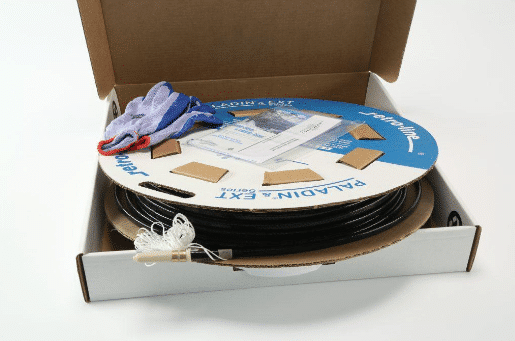Our heating cables
What is a heating cable?
At Groupe H2O, we offer heating cables manufactured by Heat-Line®, a recognized Canadian company.
Heating cable is an electrical cable that prevents a structure from freezing. In plumbing, it is often used inside drinking water and wastewater pipes.
The most efficient heating cable is self-regulating. This cable is made of several layers, including a carbon layer that allows for self-regulation of the cable temperature. In other words, self-regulation means that the cable can adjust the heating locally. When there is a cold spot in the pipe, the cable heats up more, but only at that point.

However, there are limits to self-regulation. Indeed, the cable always gives a minimum heating power and also reaches a maximum power. Ideally, the pipe heated by a cable should also be insulated to retain its heat.
When a heating cable is inserted into a water pipe, two more elements are essential:
- Electrical contact with water requires grounding protection (GFI).
- Contact of materials with potable water requires that the cable be NSF61 certified.
This certification ensures that materials in contact with water are safe for health.
The electric heating cable prevents freezing problems in drinking water and wastewater pipes during the cold season.
Winter temperatures can cause well or septic system supply pipes to freeze. You need to hire professionals to thaw your water pipes. To prevent these inconveniences, simply install heating cables to protect your drinking water and wastewater pipes from freezing.
A cable for every pipe! In fact, the cable to use depends on the type of pipe to be heated.
At Groupe H2O, we install Retro-LineMD heating cables from Heat-LineMD.
It is a high performance product designed to be effective in extreme cold and harsh environments. It performs best where the pipe is coldest.
Retro-Line® heating cable is installed inside drinking water pipes and provides good freeze protection. It can also be used in pipes, even if there is no water. It will not melt the pipes.
In the event of a power outage, it is possible for the water line to freeze. The heating cable will come back on as soon as the power returns and will gradually thaw the water line.
It is recommended that the installation be done by a professional, in order to ensure optimal performance. Before installing a Retro-Line® heating cable, you must:
- Measure the length of the pipe to be protected.
- Choose the right power to keep your car from freezing in the winter.
- Properly insulate the pipe to reduce energy costs.
We also offer other products manufactured by Heat-Line®, such as Retro-DWSTM cable designed for wastewater pipes.
Installation : $
Maintenance : $

Photo of a heating cable inserted in a water pipe by a technician.

Photos of our most popular heating cable in its packaging: the Retro-LineMD de Heat-LineMD.

Photos of our most popular heating cable in its packaging: the Retro-LineMD de Heat-LineMD.
